Article 4
F
ines, are naturally occurring small wood particles created during the process of chipping, or sawdust added into a blend of chips in some sawmilling operations, need to be removed prior to processing for pulping.
Traditionally this has been done using a shaker/rotary screens fit with various types of fine mesh screen decks. Limitations to rotary screen operation have driven the development of alternative technologies, which now include roll screens. These new technologies incorporate a wide variety of innovative features which allow for a much wider application.
Rotary Screens
A typical rotary screen will be loaded by dumping fines and chips directly on the landing deck at the infeed end of the screen. The rapid circular motion of the landing deck will cause the pile of chips to spread laterally, and the angled nature of the installation will encourage the movement of the materials down the screen onto the fines screening deck. As the small fines encounter holes in the screening deck they can pass through the opening, while the larger chunks and pieces are excluded and moved down the deck itself. As long as there are no holes in the screen plates, the fines that are rejected in the screening operation tend to be fairly uniform and conform to the nominal dimensional opening of the screen plate.
What makes a rotary screen work? Essentially it is a question of the fine particles’ access to the screen openingRoll. There is a statistical probability that a fine particle will find an opening.
Articles have been written by scientists who have examined this process fairly carefully – if it is possible to calculate the statistical probability of any particular particle to find an opening of a certain dimension and pass through it. These theoretical considerations are used here to calculate the “conventional wisdom” factors used to size and apply most rotary screens in the wood processing industry. Surprisingly, they are in accord.
The failure of a fine particle to find an opening on a screen deck is usually a function of several factors. First on the list is competition from other near-sized and larger particles. This could be a simple loading rate problem – as long as you provide enough opportunity for the competing particles to reach the screen surface, then the screen will have sufficient capacity.
Creating a fluid condition within the screening material is essential. Fluidity in this sense is an active, turbulent environment in which the overburden of large particles does not prevent the fine particles from reaching the screening surface itself. To achieve fluidity it is necessary for the screen to have a certain velocity of rotation and frequency. Traditional screens had a typical operating RPM of 180. At this rate it was possible for the material to move sluggishly down the screen plate, preventing this fluid condition. Current screens operate at between 235 and 300 RPM. This higher frequency, coupled with modifications in the amplitude of motion, creates the necessary fluid condition.
In general there is a relationship between the screen operating speed and total amplitude. Slower screens tend to move in larger circles of motion. High-speed screens have a very small amplitude of motion. This is necessary to control the forces generated in moving the mass of the screen with the counterweight drive system. Fines screening is favored by high speed and low amplitude. Overs screening is more tolerant of slower speed as long as there is sufficient amplitude. In most sawmill applications; these two screening functions are combined in a single screen.
Dual Drive Suspended Rotary Screen mounted over DiamondRoll Screen
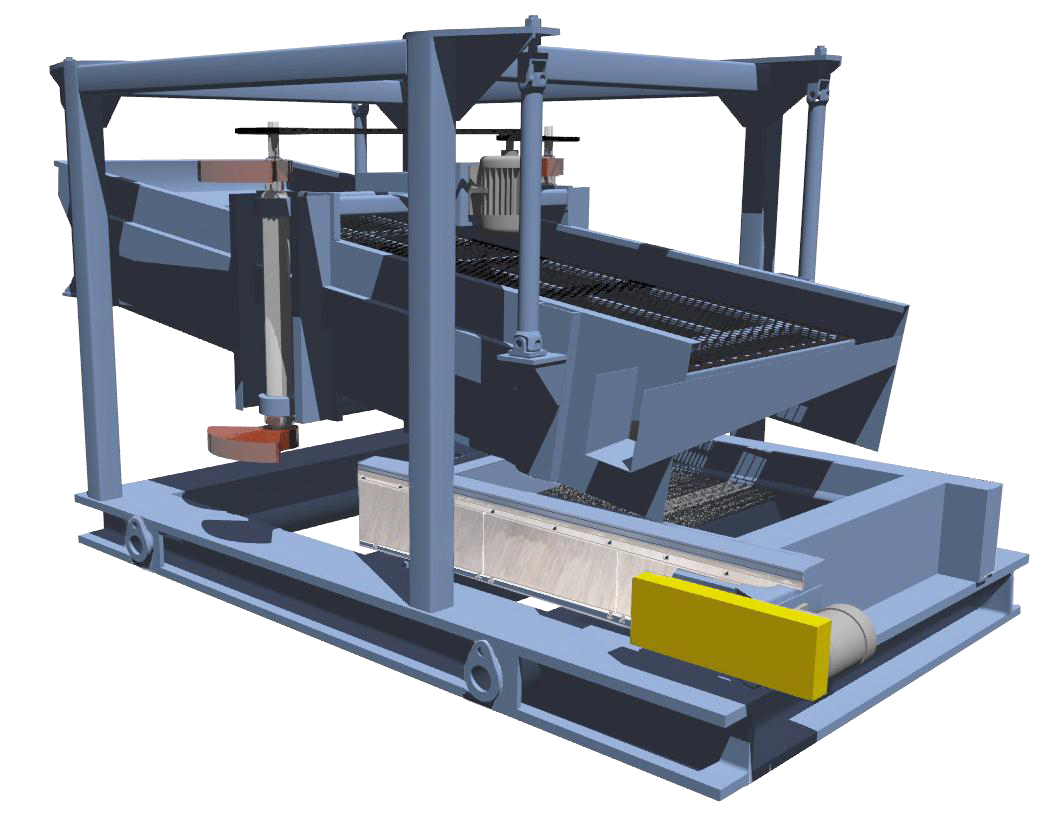
Cold weather operations require special approaches,
and by combining some of the advantageous features of the Dual Drive Suspended Rotary
Screen with a DiamondRoll® Fines Screen, it has been possible for installations to reap the benefits of both.
The decline angle of the screen plate is almost universally considered to be between 7 – 8°. Some screens which have been used in forest products applications come to us from the aggregate screening, or mining. The screens tend to be angled downhill at 20 – 25°. Wood chips usually have a very short residence time on the screen surface when the downhill angle is this steep. Consequently, screening efficiency is affected.
In forest products screening applications, older screens were typically made with a heavy cast or fabricated base to resist the forces created by the moving counterweight as it pushed the pan through its circular motion. It was necessary to keep five points in alignment in these types of screens: the center drive eccentric which was attached to the counterweight, and the four corner bearings. Aligning the corner bearings was always a difficult and exacting process. Failure to align them correctly resulted in premature bearing wear life.
In the last 15 years there has been a wholesale shift away from base mounted screens, to screens supported with suspension rods or cables. Mounting a counterweight on the screen pan itself frees the installation from the necessity of a heavy base, and the need to align the various components. Rather, the screen is allowed to hang freely with a counterweight driving the screen through its circular motion. These have come to be known as suspended rotary screens.
Much has been said about the difference between punch plate screens and wire mesh screens for fines removal. The general relationship is that punched plate screens offer a smooth sliding surface for the fines and pins to slide across, improving fines selectivity and restricting or limiting pins from up-ending and falling through. Using widely scattered holes improves pins retention. A wire mesh screen creates an undulating or uneven surface.
Woven wires encourage pin chips to turn sideways or end-wise to the openings. The result is that more pins are removed. This is in addition to the geometric opening space which is square, rather than round. Most punched plate screens for fines removal will have round holes so that the fines removed more accurately corresponds to the written fines specification.
One of the biggest problems with rotary screens occurs during cold weather winter operations. Snow and ice has the tendency of being screened as though they were fines. A shaker screens fines deck does not always move fines and snow as well as it should. If the snow collects and freezes to the bottom of the fines pan it takes a very short time for the entire pan to fill and blind back up to the bottom of the fines screen surface. As long as wood (pin chips) is moving in the fines pan it is possible for it to remain clear. For this reason rotary screens have received a very bad reputation in northern climates.
Roll screening
Screening fines with a textured roll surface was first developed in the late 1980s. The principle of the operation is that fine particles that fall into the textured surfaces of the rolls are passed out as the roll turns. Adjacent rolls are spaced so that only the surface-captured fines can pass between them. The active environment which takes place in the space between rolls (nip) allows the pin chips to continually pick the surface of the rolls clean. This ensures that cold weather operation does not adversely affect the operation and performance of the roll screen. Screening fines with a textured roll surface such as the DiamondRoll® Fines Screens capture fine particles and pin chips efficiently.
A typical definition for fines for pulp chips is anything smaller than 3mm round hole (-3mm RH). To achieve this separation with a DiamondRoll screen, a knurl pattern with a depth of
1.5 mm and a nip spacing of 1.0mm is used. With a total space available to pass a particle of 2.5mm dimension, the sum of these two dimensions, the screen’s surface prevents larger particles from being rejected.

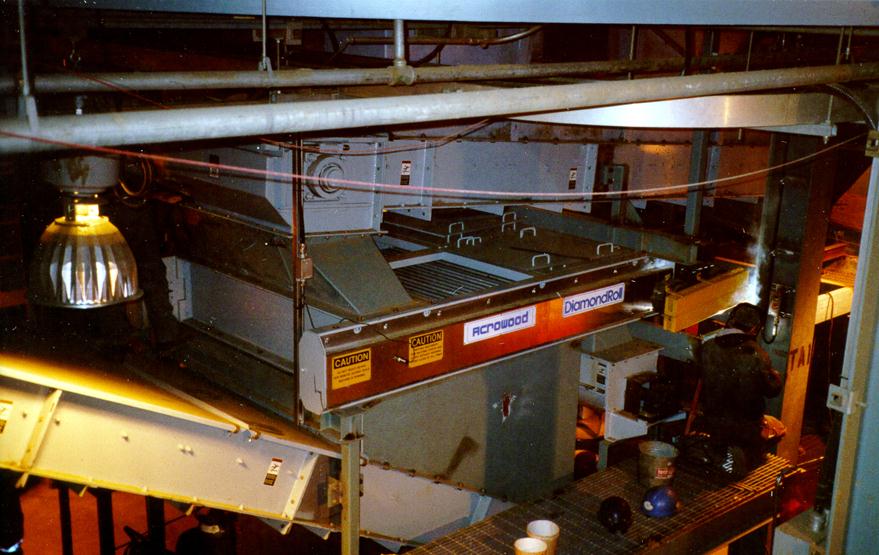
The DiamondRoll Fines Screens can be
configured to screen for both fines and pin
chips on the same screen.
The process of cutting knurls produces a surface on the shaft which is like a series of pyramids. The tips of the pyramids can be pointed or flat.
The height of the pyramid, or the depth of the space between them, represents the capture dimension of the shaft itself. Since the tip of the pyramid is really the uncut outer dimension of the solid steel cylinder before the knurling process was begun, the IRO (inter-roll opening) of the nip is the clear spacing between two effectively cylindrical shafts.
Three factors affect the overall performance of a roll screen. These are knurl depth, IRO, and roll speed. Knurl depth is the most important because the overall dimension of the depth of the valley is such a dominating factor in controlling the capture characteristic of the shaft itself. Shallow knurls can capture only smaller particles, and deep knurls can
be significantly larger than the IRO used, making this the dominating factor. Inter roll opening is second, as this is the dimension that excludes the thin woody particles from passing with the fines. Pin chip loss can be strongly affected by IRO. Roll speed has a role to play by ensuring the materials are fluidized on the screen surface, and are moved briskly from infeed to discharge, but are not sped along so quickly that the fines fail to contact the screen surface. It is possible to run a screen so quickly that almost no screening will occur.
In many installations both fines screening and pins screening is necessary in a single frame. In this case the fines screening occurs first, and typically the same knurled shafts are used in a second section where the IRO is increased by a millimeter or so. This second part becomes the pins removal section.
By adding a flop gate below the pins section, it is possible to direct the pins either to the fines removal conveyor
or to the accepts conveyor along with the chips retained on the surface of the screen. In this way the screen can control pins screening both volumetrically and qualitatively.
Fines screening efficiency is typically 80 to 90 percent. This means that sufficient surface area is provided so that 80 to 90 percent of the fines which are present in the roll screen infeed are removed. Since the screen is self-cleaning, the problems with pin chips plugging holes and gradual loss of surface area effectiveness is minimized. The shaft positions can be adjusted by the replacement of shim spacers between them, thereby altering the IRO.
The drive system on roll screens includes continuous loop chain drives and special plate sprockets which do not require lubrication. Similarly, the bearings which support the shafts are lubricated at the factory and do not require grease. The shafts are solid alloy steel, fully surfaced chromed for long service life. Design enhancements include center bumpers to prevent shaft contact, further prolonging service life. When the chrome begins to fail it is possible to re-chrome the shaft, reusing the essential core shaft material for another cycle of operation. In short, this is a design built to last.
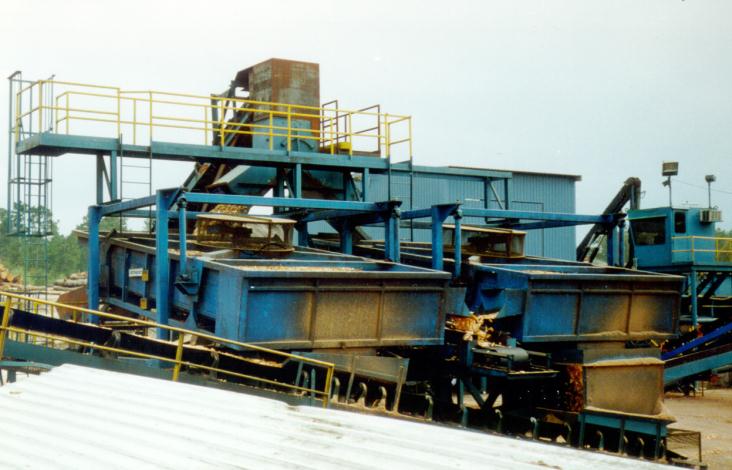
Suspended rotary screens are allowed to hang
freely with a counterweight driving the screen
through its circular motion.
Cold weather operations still require special approaches. By combining some of the advantageous features of the Dual Drive rotary screen with a DiamondRoll Fines screen, it has been possible for installations to reap the benefits of both. By using a large fines deck hole opening, typically ⅜” or larger, it is possible to keep the fines deck from freezing in the winter. Passing this pin enriched fines fraction to a DiamondRoll screen allows it to do the final sort. This Dual Drive Rotary/DiamondRoll combination is popular in northern sawmills where frozen wood processed by small log optimization equipment can produce upwards of 20% pin chips during the coldest winter months. Trimming this pins chips level before it reaches the pulp mill is essential for pulp mill operation. Reducing the flow to the DiamondRoll screen by using the rotary screen in the primary position keeps the overall installed cost low.
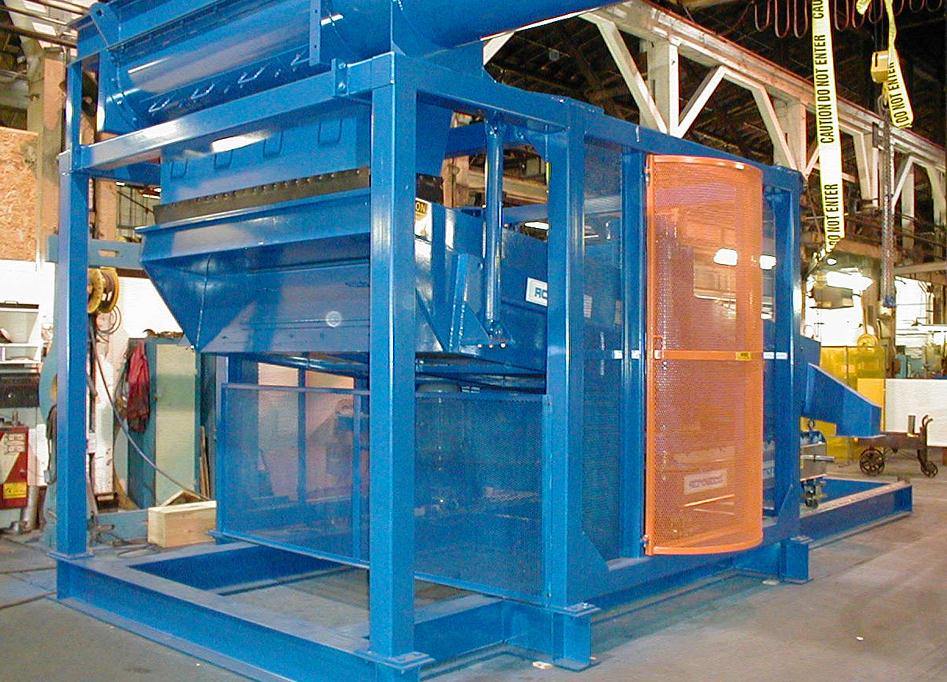
Fines removal can be achieved with other
screening methods, as well.
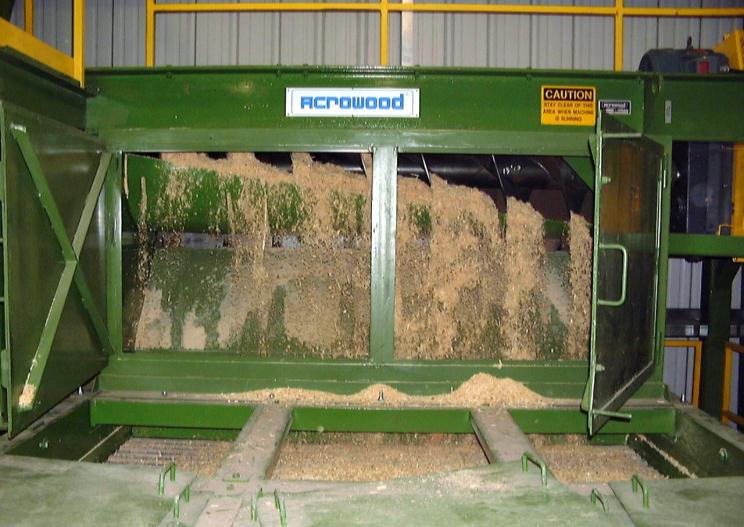
Explore Acrowood Fines Screening Solutions
Let us send you this Case Study and any others you need.
